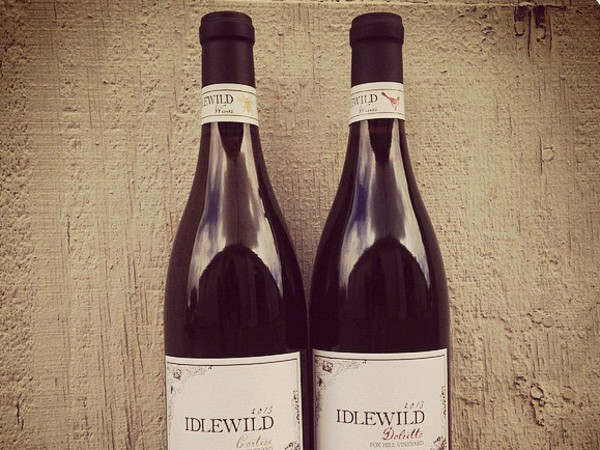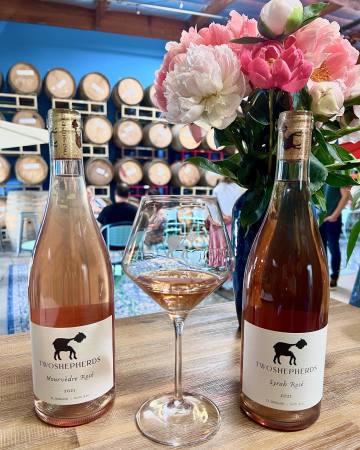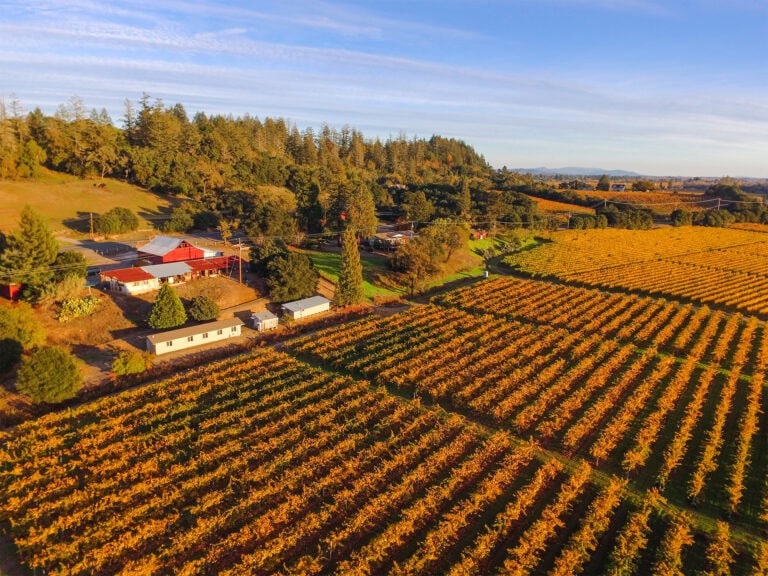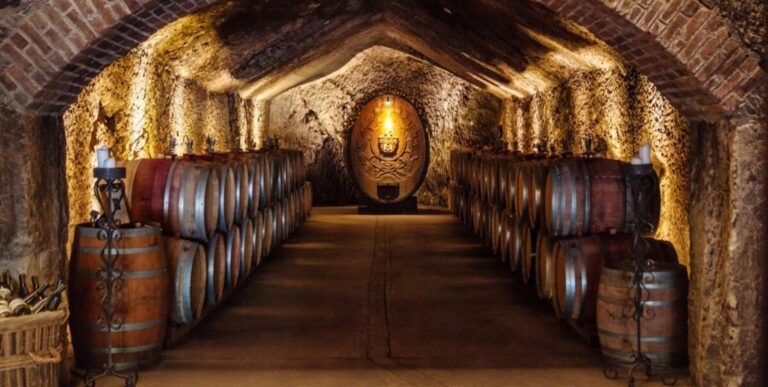Orange Wine? Your Guide to Skin-Fermented White Wines in Sonoma County
Skin-fermented or skin-contact white wines are white wines that have had extended contact with grape skins. This is unique, because typically, white wines do not spend time on their skins during fermentation. When white wine grapes are pressed, only the juice is fermented. Whereas, when red wines and rosés are fermented and pressed, they spend time on the skins (much less time for rosés than for reds). This extended skin contact is what gives wines their color and tannin.
Often known as “orange wines” due to their color, skin-contact whites have started trending in a big way, with wineries in regions all over the world starting to experiment with producing this style of white wine.
More recently, modern wineries and winemakers have started to exercise more restraint when it comes to skin-fermented white wines, experimenting with less time on the skins and other techniques in order to produce wines that are more subtle and less tannic.
So, what do skin-fermented white wines taste like? And are all skin-fermented white wines “orange wines” even if they aren’t orange in color?
First, there are aromas, flavors and components found in skin-fermented white wines that are much less commonly found in traditional or non-skin-fermented white wines. The additional time on skin results in more tannic wines with stronger, deeper fruit notes, as well as a fuller body and texture. Ripe stone fruit, orange peels, and white flowers are common descriptors of skin-contact white wines. The added complexity and weight of these wines also mean that they pair with a different and wider variety of foods than lighter-bodied white wines.
Second, not all skin-contact white wines are orange wines, but all orange wines are skin-contact white wines. What does this mean? Not all white wines that receive skin contact turn orange or are as deep in color. The level of color and tannin a wine achieves depends on how long it spends on the skins, the varietal of the grape, and to an extent, the vessel (in relation to oxidation).
Curious about who’s making skin-contact white wines in Sonoma County? Here we highlight a few favorites.
DeLoach Vineyards Skin-Fermented Ribolla Gialla

DeLoach Vineyards is one of only a few wineries in Northern California that make a Ribolla Gialla wine. Ribolla Gialla is a grape hailing from the Friuli-Venezia region in northeastern Italy that is known for producing bright wines with citrus and floral characteristics.
DeLoach’s skin-fermented version of this wine is a gorgeous example of how aromatic and complex Ribolla Gialla can be, displaying aromas and flavors of juicy white pears, giving plenty of minerality and freshness, and offering a mouthfeel that is juicy and round without being heavy or creamy.
The winery ferments this wine in clay amphora pots that are buried in the ground before moving the wine to concrete tanks where it then spends six months before being bottled.
Idlewild Wines Skin-Fermented Cortese
Idlewild Wines in Healdsburg is the only winery, to our knowledge, that produces a Cortese wine in Sonoma County. Cortese is a white Italian grape varietal known for producing lean and light-bodied white wines with moderate to high acidity and nice minerality. The white wine most often associated with the Cortese grape is Gavi.
Idlewild’s Cortese spends a short amount of time on the skins fermenting in large neutral Slovenian oak’ botti’ (large oval casks popular in northern Italian wine regions), allowing the wine to retain its freshness while also rounding out its edges and offering a fuller mouthfeel.
This wine is bright and lean yet concentrated with aromas and flavors of lemon verbena, white tea, and sage, and a touch of saline/brininess.
Joseph Jewell Pinot Gris

Joseph Jewell specializes in cool vineyard site Pinot Noirs from Humboldt County and Sonoma County vineyards as well as a few eclectic and unique white wines and sparkling wines including Vermentino, sparkling Vermentino, and a skin-fermented Pinot Gris.
While Pinot Gris is most often associated with white wine and therefore assumed to have white or green skins like most white wine varietals, Pinot Gris actually has pinkish/grey-skinned fruit and more pigmentation than most white wine grapes.
By leaving this Pinot Gris on its skins during fermentation, the winery has allowed the wine to take on a pinkish, almost watermelon-type hue as well as much more pronounced flavors and a more substantial texture than would be found in a typical non-skin-fermented Pinot Gris.
This wine exhibits notes of citrus, tart red berries, melon and tropical fruit and has a thirst-quenching character yet is still a dry wine. Winemaker Adrian Manspeaker calls this Pinot Gris “a fantastic sushi wine.”
Kivelstadt Cellars Wayward Son Orange Wine (Roussanne)

Kivelstadt Cellars has a knack for the unconventional as well as for bright, fresh, quaffable wines (both reds and whites). So, it’s unsurprising that this orange wine from Kivelstadt winemaker Sam Baron is more refreshing than the orange color may indicate.
Sourced from an organically farmed, high-elevation vineyard in Lake County, this Roussanne spends 13 days on the skins before being moved into neutral French oak barrels where it spends six months on the lees (adding to the concentrated layers found in this wine) before being bottled, unfined and unfiltered.
The end result? A white wine that feels like a red wine in your mouth and offers up bright, citrus flavors and aromas alongside pretty notes of white or green tea.
Pellegrini Skin-Contact Chardonnay

Pellegrini-Olivet Lane Winery is a fourth-generation family-run winery that specializes in both growing and sourcing grapes from select vineyards in Sonoma County. While the winery has traditionally focused on Pinot Noir (both growing and selling premium Pinot Noir grapes as well as vinifying their own red, rose, and sparkling Pinot Noir-based wines), the winery also produces a unique white Pinot Noir and a skin-contact/skin-fermented Chardonnay.
This skin-contact Chardonnay displays a darker-yellow hue than non-skin-fermented Chardonnay as well as aromas of hazelnut, baking spices and fresh pepper. On the palate, it’s soft and round while the wine feels at the same time fresh and bright, exhibiting flavors of lemon curd, vanilla wafers and dried orange peel. Food-pairing suggestions from the winery for this wine include dishes with creamy sauces, fried polenta with mushrooms, and lobster bisque (are you hungry yet?).
Two Shepherds Skin-Fermented Pinot Gris, Trousseau Gris, Grenache Blanc, Grenache Gris and Vermentino
Two Shepherds is a small, independently owned winery located in Windsor’s Artisan Alley. The winery crafts natural wines made from organic grapes and unusual or rare varieties. The focus here is on fresh, easy-to-drink wines that aren’t overloaded with too much oak and are naturally low in alcohol.
Two Shepherds makes a handful of skin-fermented white wines including Pinot Gris, Trousseau Gris, Grenache Gris, Grenache Blanc, and Vermentino. All of these wines have something in common: They are fermented for only a very short time on the skins (between five and 13 days, depending on the varietal) in order to produce a lighter, fresher wine with lower tannins and alcohol than traditional orange wines (which spend much more time on their skins). All of Two Shepherds’ skin-fermented white wines are also fermented with native yeast and aged in neutral oak barrels.
Written by Brooke Herron
This Is Wine Country.
Share your experience using #SonomaCounty or #LifeOpensUp






















